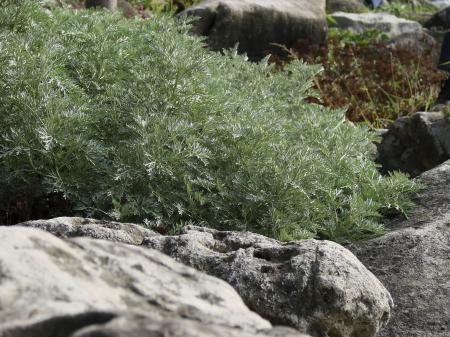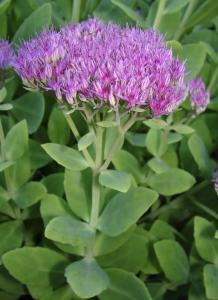 | |
| Rocks add a wonderful texture to the garden. |
Creating a rock garden on an existing slope can turn a difficult planting area into a garden asset. Using the rocks to create a series of terraces forming flat planting areas avoids the problem of erosion from rain or nitrogen.
The rocks should be well sunk in the ground and should have the finished appearance of a natural outcrop. For this natural look, the rocks should be of only one type and the larger the better. It is a common mistake to use rocks that are too small. Fewer but larger rocks are more impressive.
Rock gardens are raised planting areas
Rock gardens are often constructed in conjunction with a garden pool. Using the excavated soil from the pool area as a base for the rock garden is simpler than getting rid of it otherwise. Even if the water garden is not in your plans, the same end can be achieved by creating a sunken garden as an attractive seating area or patio. The pool or seating area should be on the south or sunny side of the rock garden.
 | |
| Sedums are ideally suited for rock gardens. |
Because a rock garden is a raised area, plants enjoy good drainage which is important in winter. The soil will also warm up more quickly in spring to the benefit of many popular rock garden plants that are spring flowering. The earliest flowering plants are the small bulbs such as Snowdrop, Crocus and Winter Aconite. These are ideal rock garden plants and are usually in bloom by mid-March. Ground Phlox in many colours, white-flowered Rock Cress (Arabis) and blue or purple-pink False Rock Cress (Aubretia), follow in April.
Perennial Alyssum (on Aurinia) is the popular Basket of Gold with showers of bright yellow blooms. The well drained soil of the rock garden is an ideal place for a collection of Thyme varieties, many with coloured foliage and flowering in many shades of pink plus white. Woolly Thyme is a favourite that will form a low carpet over the rocks.
The Sedums or Stonecrops are another family ideally suited to rock gardens. All have interesting foliage in many shades of green, green and gold and wine-red. They all flower with starry blooms in white, yellow, pink and red. They vary greatly in their bloom times, so that with a full collection, one Sedum or another will be in flower from early summer to fall.
Sempervivums or Hens and Chickens are rosette-forming plants that can be inserted into holes in the rocks or into rock crevices.
With the exception of spring bulbs, most of the perennials mentioned so far are not truly herbaceous but are sub-shrubs or have winter persistent stems or foliage. The winter interest is no doubt one reason for their longtime popularity.
Dwarf Evergreens and Dwarf Shrubs
It is always the garden ideal to have year-round interest. Evergreen plants provide this in many garden situations and many dwarf varieties are perfect for rock gardens. The very low-growing Juniper 'Blue Rug' forms an evergreen carpet suited to the lowest level of the rock garden. In the middle tier, round or arching shapes are found in the many choices available from dwarf forms of Juniper, Hemlock, Spruce and False Cypress.
Pyramidal forms have great architectural merit, adding solidity and permanence to the design and perhaps reminding us of mountainous regions. Alberta Spruce is a slow growing dwarf that requires no maintenance. Sunkist Cedar is burnished gold and very striking in winter.
Many smaller forms of flowering shrubs can be used in the rock garden. Potentillas are naturally small enough and dwarf forms of Lilac, Weigela, Spirea, Deutzia, etc. are all available.
Balance and Design
The suitability of any plant in the rock garden is dictated by the size of the rocks. It has already been stated that fewer larger rocks are preferable to many small ones. The larger the rock, then the larger the plant may be to achieve a visual balance. Smaller rocks should be used with smaller plants. The bare rocks and soil should have a pleasing effect even before planting.
It is unlikely to have rocks of pyramidal or roundish shapes (boulders are not recommended) so contrast in design is found in pyramidal and spherical plant forms.
Plants with a cascading habit are well-placed coming down over the rocks. Weeping Hemlocks, Weeping Spruce and shrubs like Cutleaf Stephenandra and Cranberry Cotoneaster will follow the contours of the rocks. It is not the only Cotoneaster for rock garden use, but it is one of the best with wine-red foliage in fall and winter persistent bright red fruit.
On the shady side
Depending on the placement and construction of your rock garden which should be in the sunniest location, you may nevertheless have a shaded area. Here, one can use small Ferns, Primrose and other shade-loving plants. Saxifrage are small rosette-forming plants with starry flowers not unlike Sedums and appear to be typical rock garden candidates. But they need moist shaded locations so they are not to burn and wither. The very lowest level of rock garden where moisture might accumulate can also provide a home for atypical plantings — Lungwort, Prunella, Hosta and other plants more normally used in woodland settings.
No hard and fast rules can be set for which is or is not a rock garden plant. Look, for example, at Shooting Star (Dodecatheon) a plant of moist woodland shade, which was chosen as the floral emblem of the American Rock Garden Society!